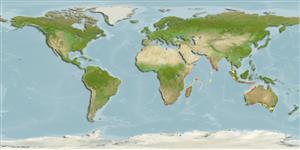>
Carangiformes (Jacks) >
Carangidae (Jacks and pompanos) > Trachinotinae
Etymology: Trachinotus: Greek, trachys, -eia, -ys = rough + Greek,noton = back (Ref. 45335).
More on author: Smith.
Environment: milieu / climate zone / depth range / distribution range
Ecología
marino; salobre asociado a arrecife; rango de profundidad 20 - 50 m (Ref. 28016). Tropical
Indian Ocean: Gulf of Aden and Oman, Mozambique and South Africa to western Indonesia.
Tamaño / Peso / Age
Maturity: Lm ? range ? - ? cm
Max length : 92.0 cm TL macho / no sexado; (Ref. 3287); peso máximo publicado: 14.1 kg (Ref. 3287)
Espinas dorsales (total): 7; Radios blandos dorsales (total): 21-23; Espinas anales 3; Radios blandos anales: 19 - 21.
Adults inhabit coastal areas with reefs or rocky outcrops (Ref. 3197). They are found normally in pairs on reefs but may be solitary or form schools (Ref. 5213, 90102). Juveniles in sheltered bays. Adults feed on mollusks (mussels) and crabs (Ref. 5213).
Life cycle and mating behavior
Madurez | Reproducción | Puesta | Huevos | Fecundidad | Larva
Smith-Vaniz, W.F., 1984. Carangidae. In W. Fischer and G. Bianchi (eds.) FAO species identification sheets for fishery purposes. Western Indian Ocean fishing area 51. Vol. 1. [pag. var.]. FAO, Rome. (Ref. 3287)
IUCN Red List Status (Ref. 130435)
Threat to humans
Harmless
Human uses
Pesquerías: escaso valor comercial; pesca deportiva: si; Acuario: Acuarios públicos
Más información
Nombres comunesSinónimosMetabolismoDespredadoresEcotoxicologíaReproducciónMadurezPuestaAgregación para la puestaFecundidadHuevosEgg development
ReferenciasAcuiculturaPerfil de acuiculturaRazasGenéticaElectrophoresesheritabilidadEnfermedadesProcesamientoNutrientsMass conversion
Herramientas
Special reports
Download XML
Fuentes de Internet
Estimates based on models
Preferred temperature (Ref.
123201): 18.3 - 28.2, mean 26.2 °C (based on 49 cells).
Phylogenetic diversity index (Ref.
82804): PD
50 = 0.5000 [Uniqueness, from 0.5 = low to 2.0 = high].
Bayesian length-weight: a=0.02042 (0.00851 - 0.04901), b=2.84 (2.65 - 3.03), in cm total length, based on LWR estimates for this Genus-body shape (Ref.
93245).
Nivel trófico (Ref.
69278): 3.4 ±0.35 se; based on food items.
Resiliencia (Ref.
120179): Medio, población duplicada en un tiempo mínimo de 1.4-4.4 años (Preliminary K or Fecundity.).
Fishing Vulnerability (Ref.
59153): High vulnerability (57 of 100).
Nutrients (Ref.
124155): Calcium = 36.3 [16.0, 66.7] mg/100g; Iron = 0.608 [0.341, 1.244] mg/100g; Protein = 19.4 [17.4, 21.4] %; Omega3 = 0.103 [0.063, 0.184] g/100g; Selenium = 40.6 [21.7, 82.3] μg/100g; VitaminA = 25.4 [6.5, 92.8] μg/100g; Zinc = 0.965 [0.641, 1.400] mg/100g (wet weight);
